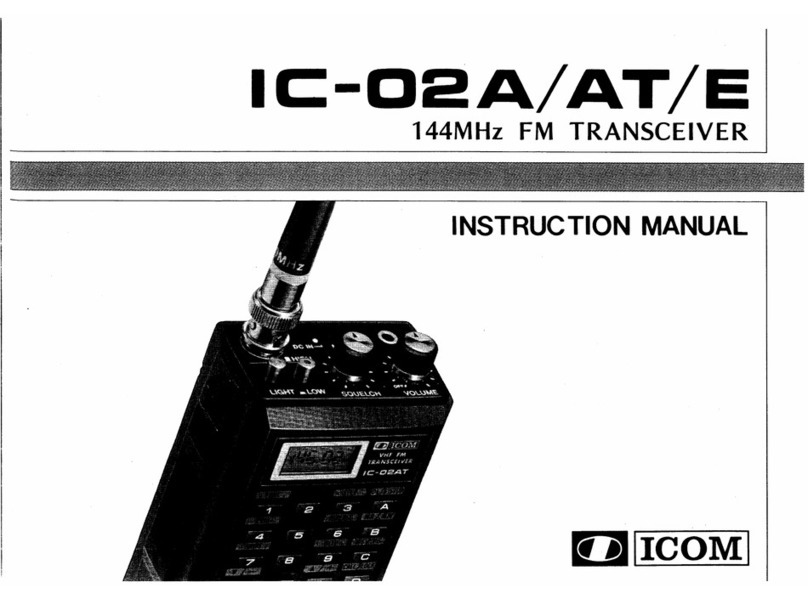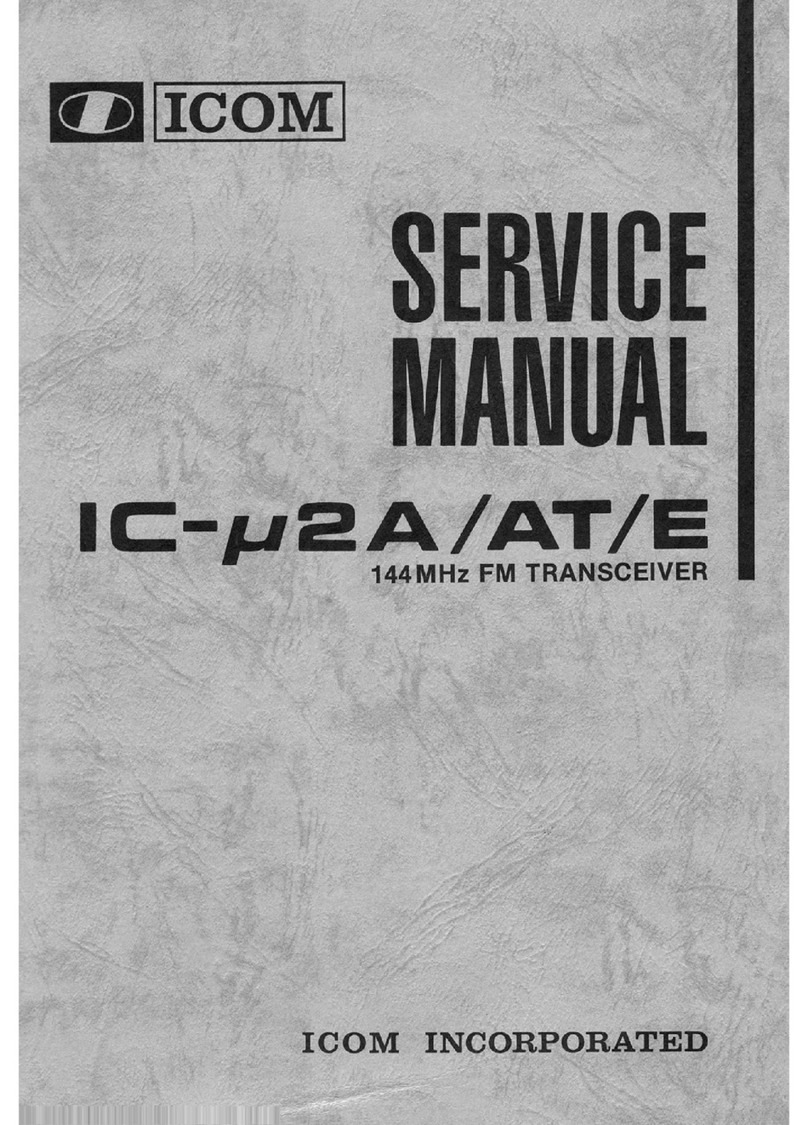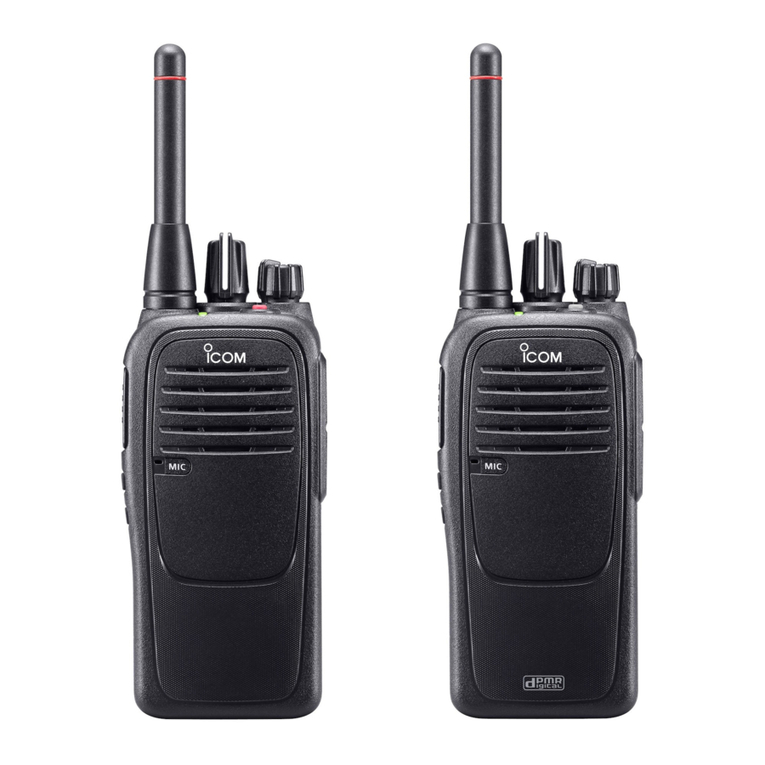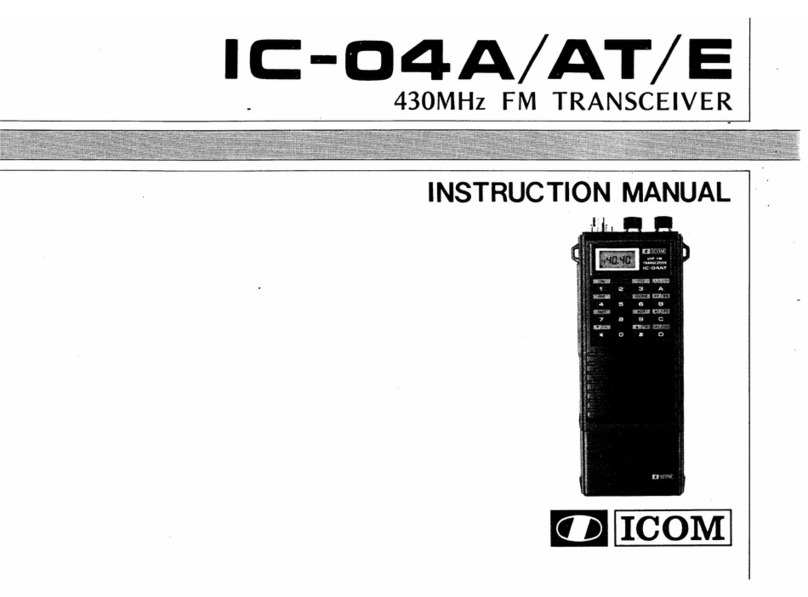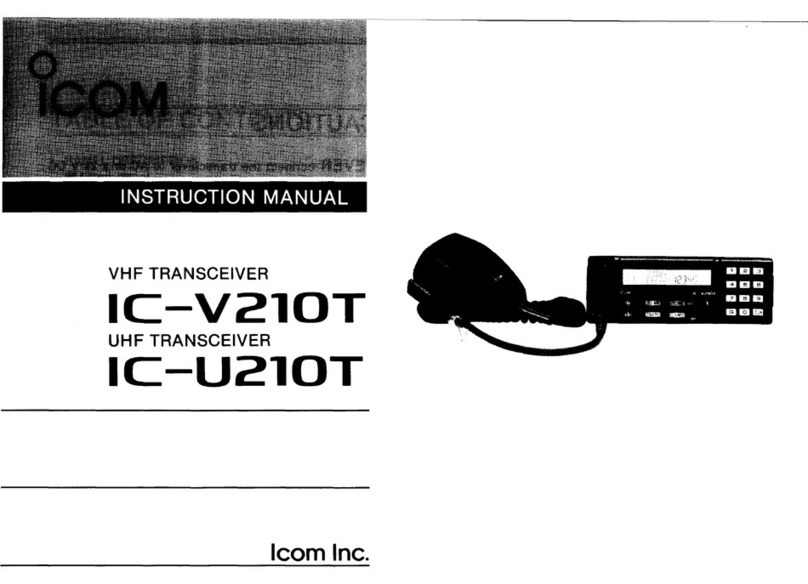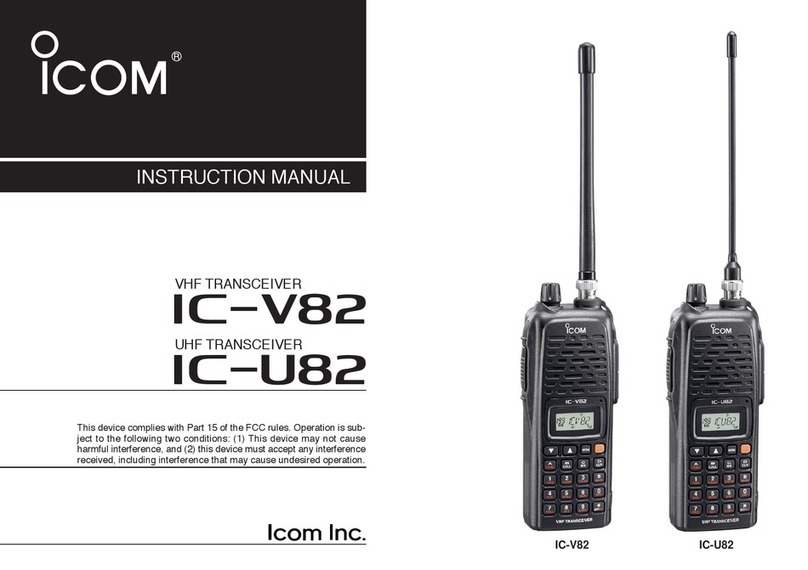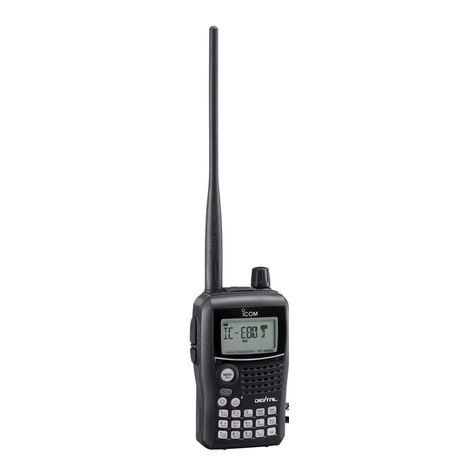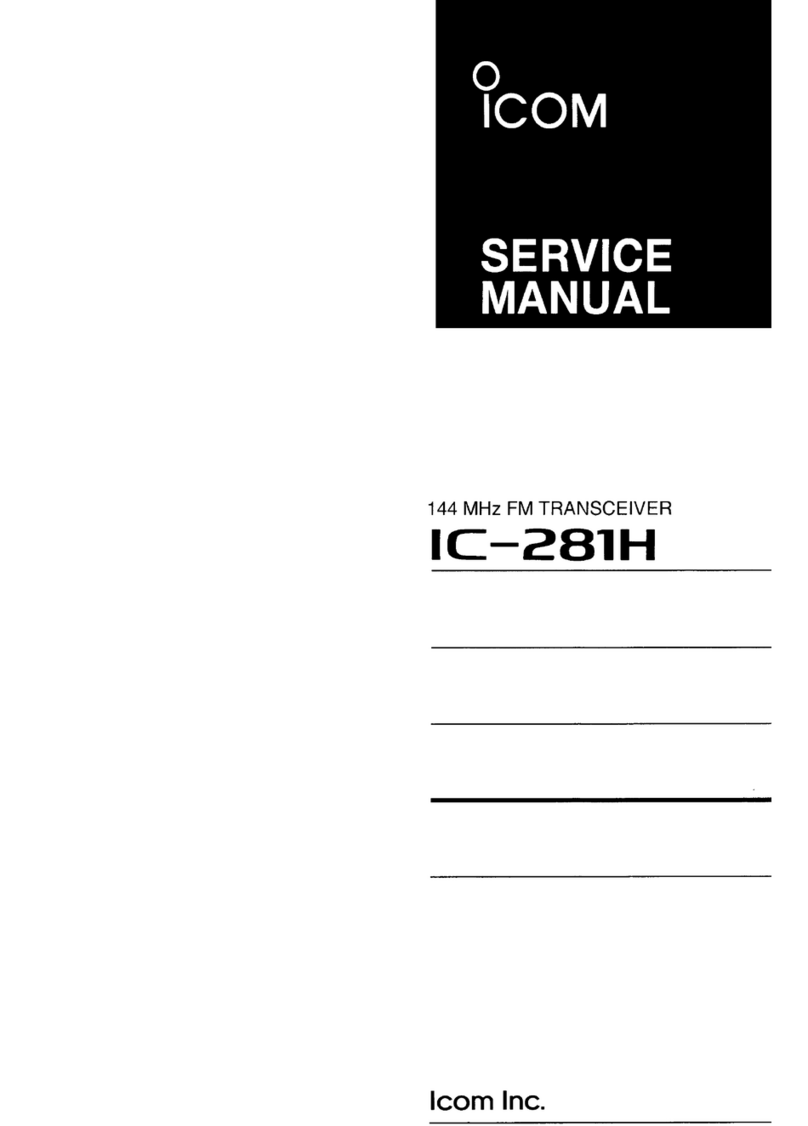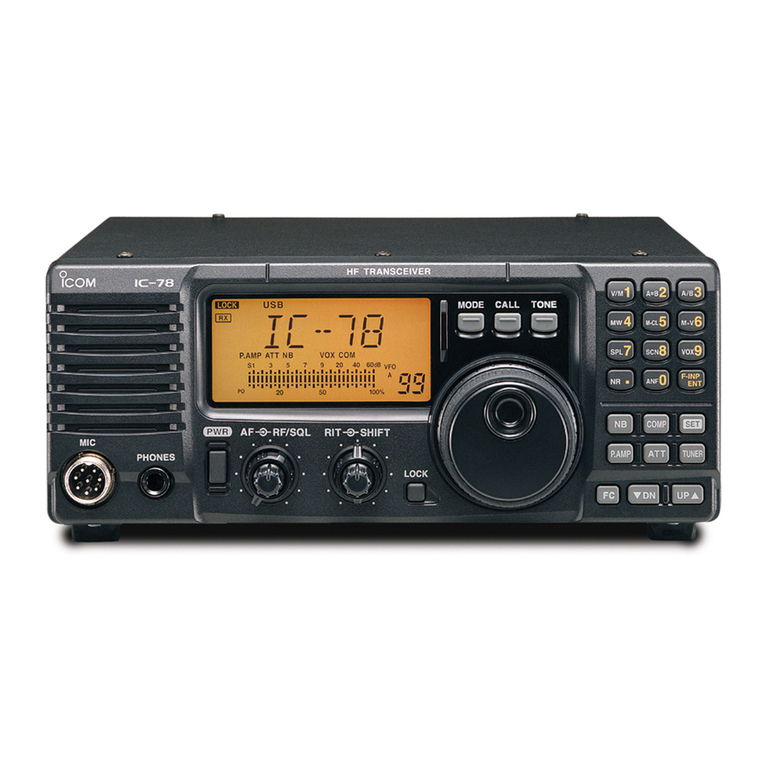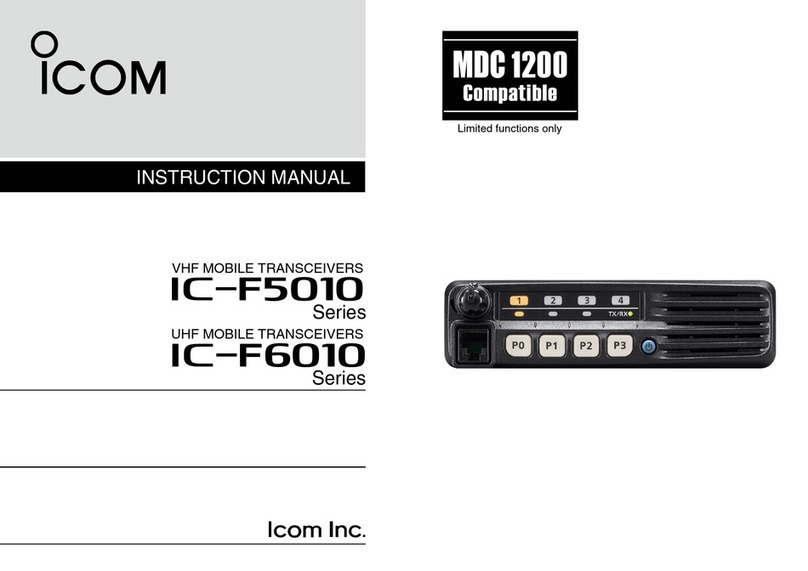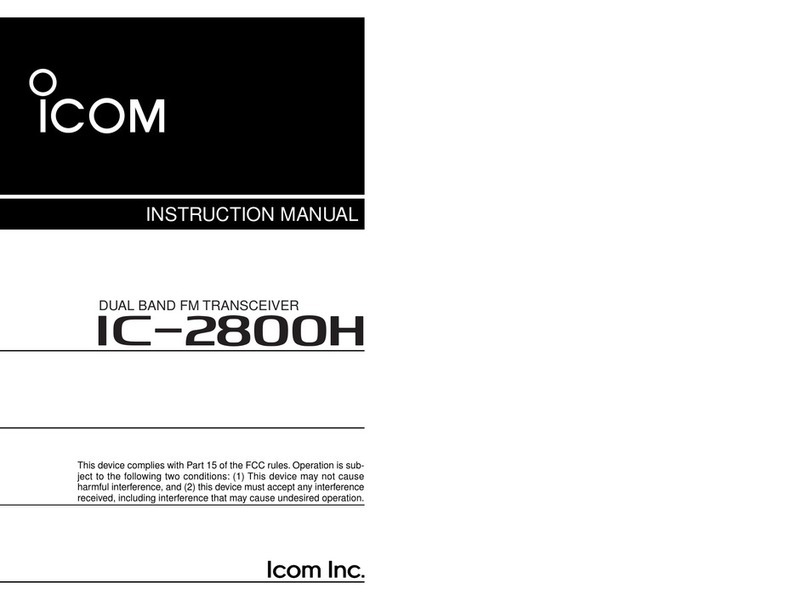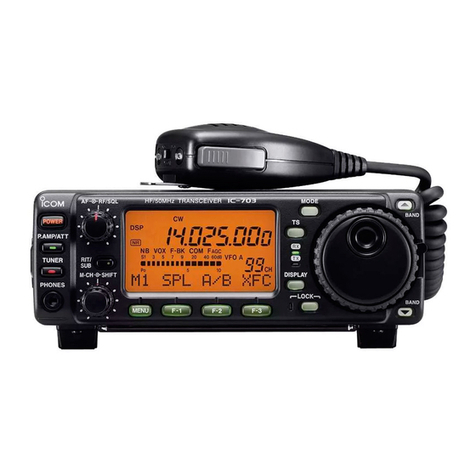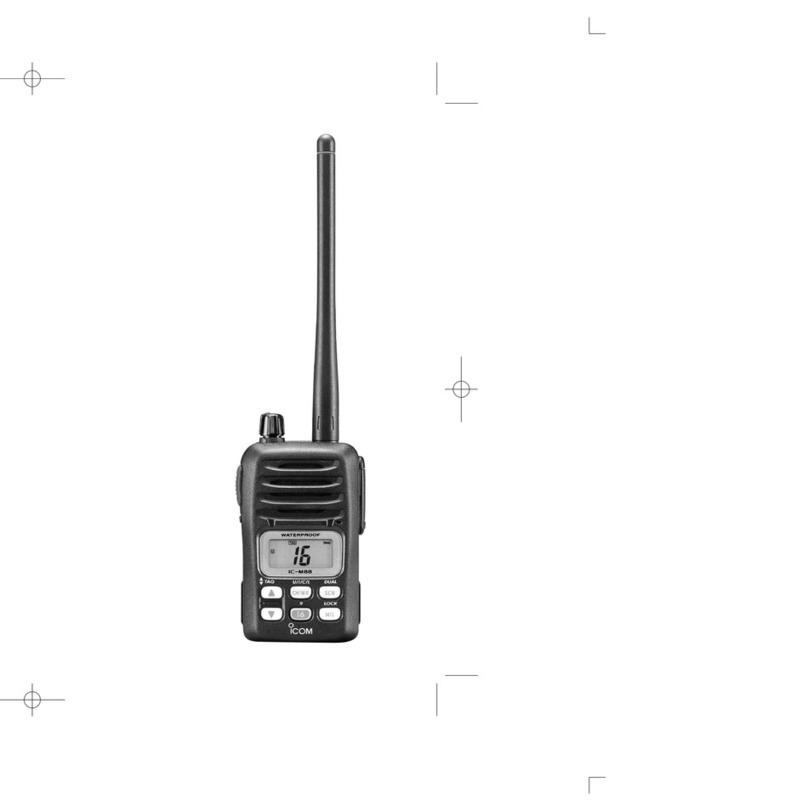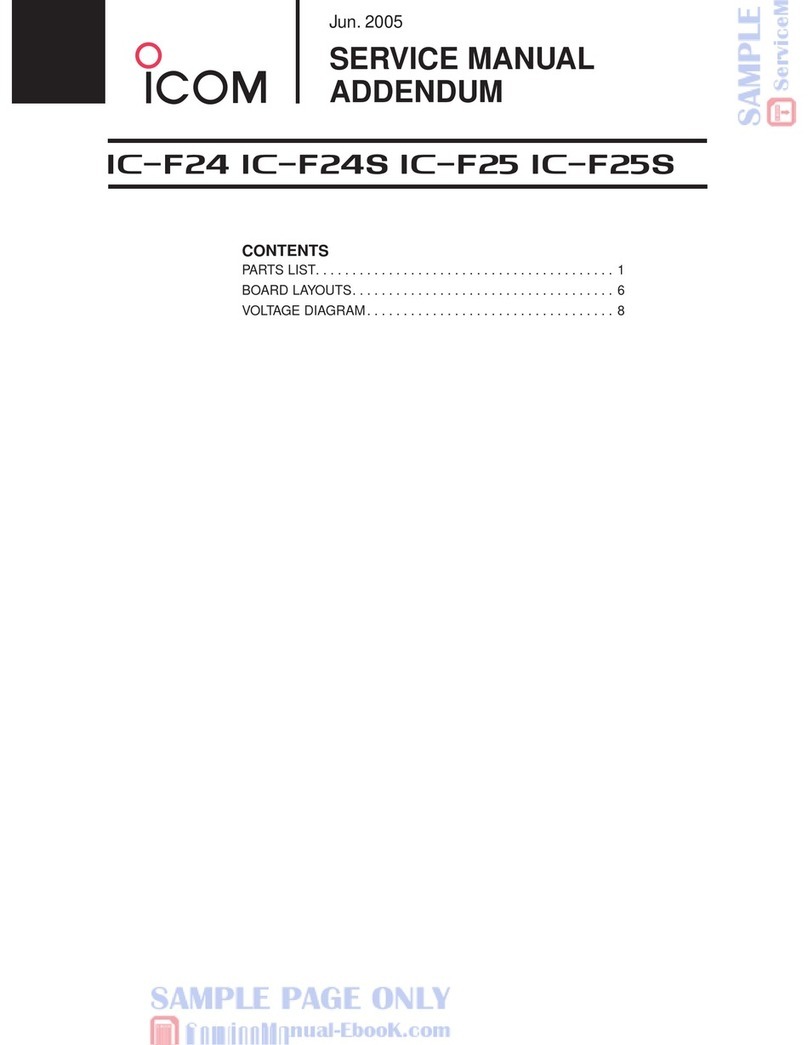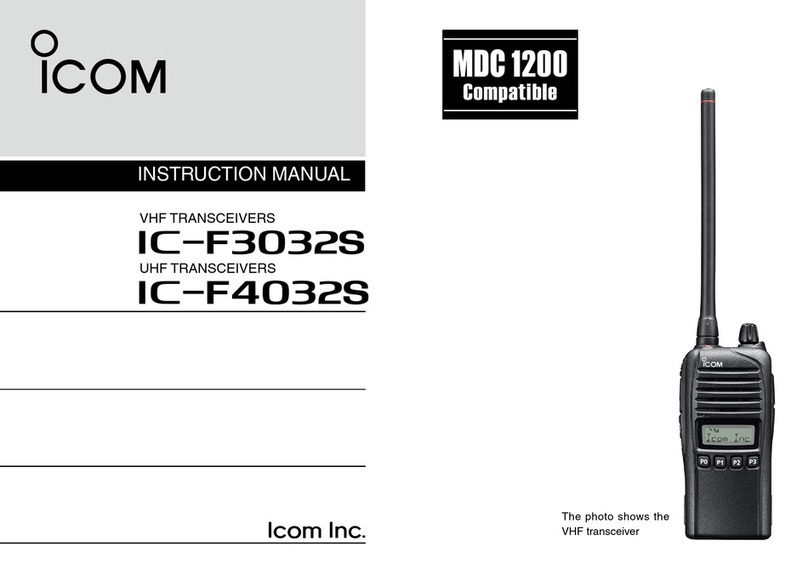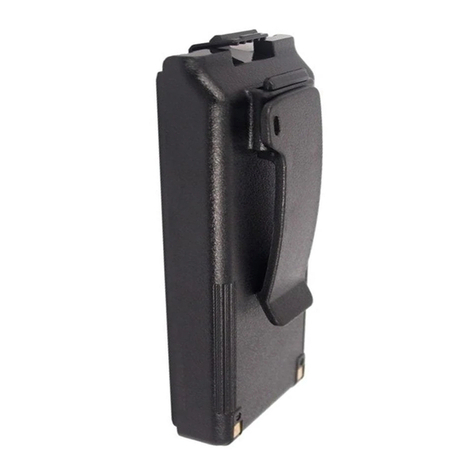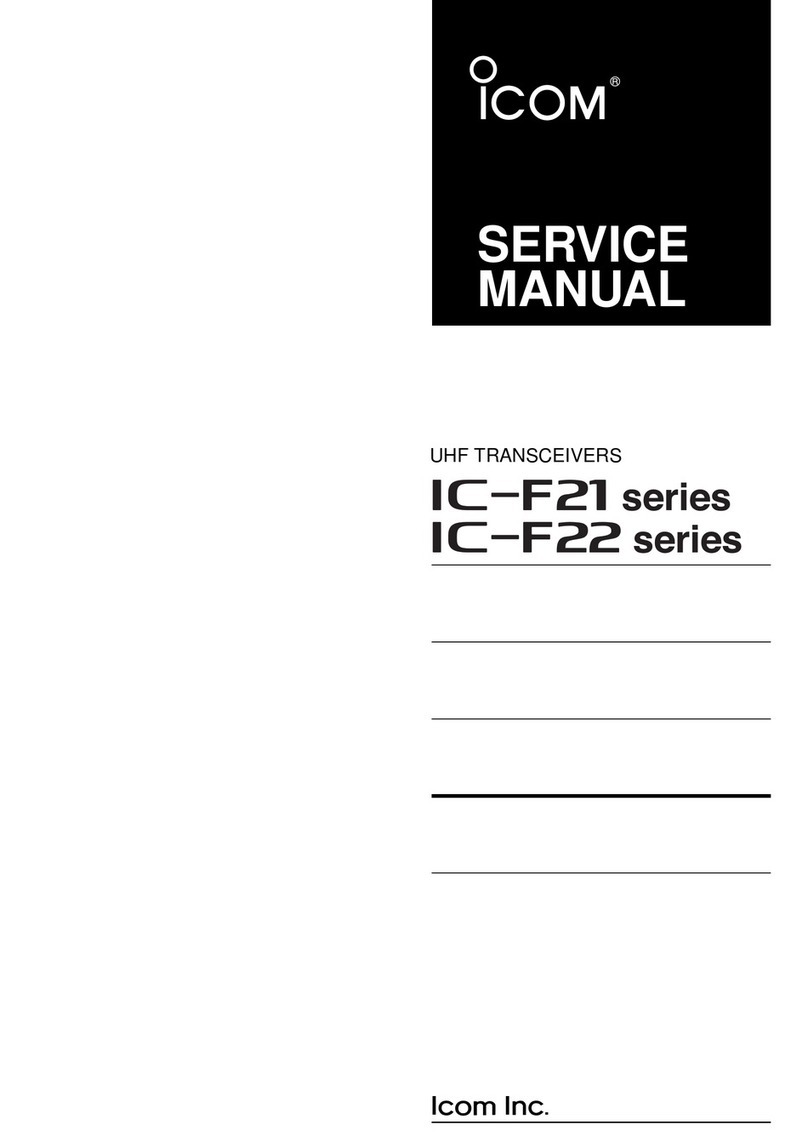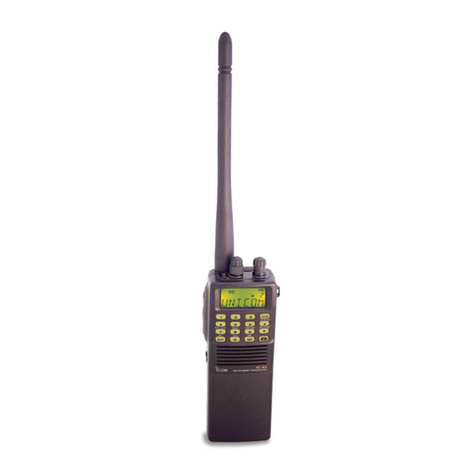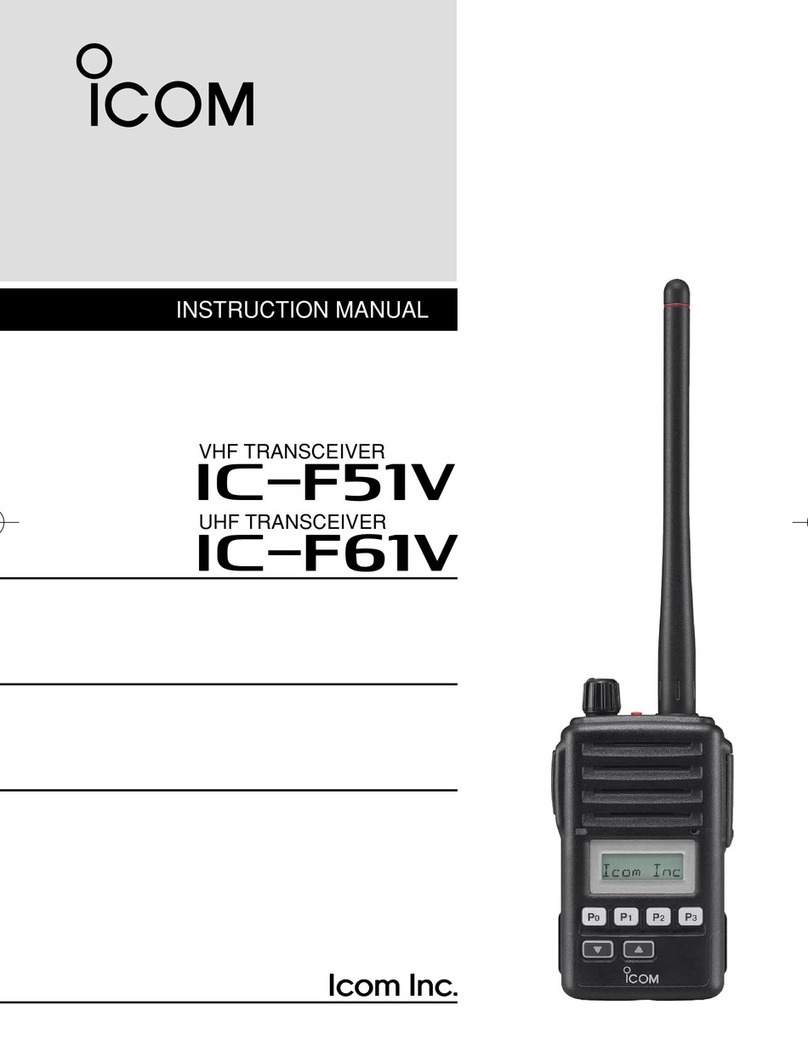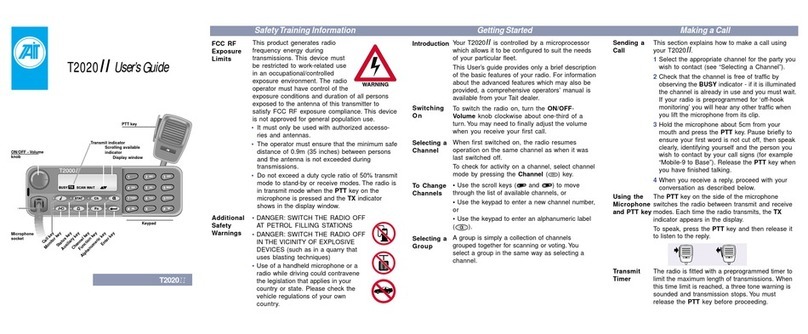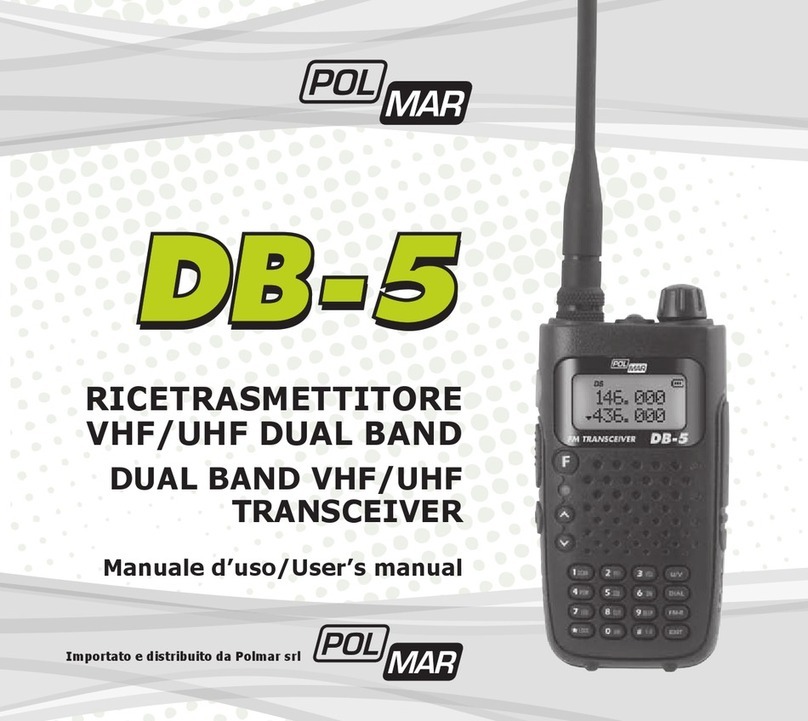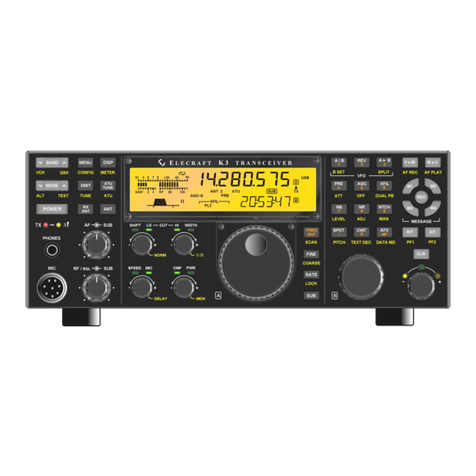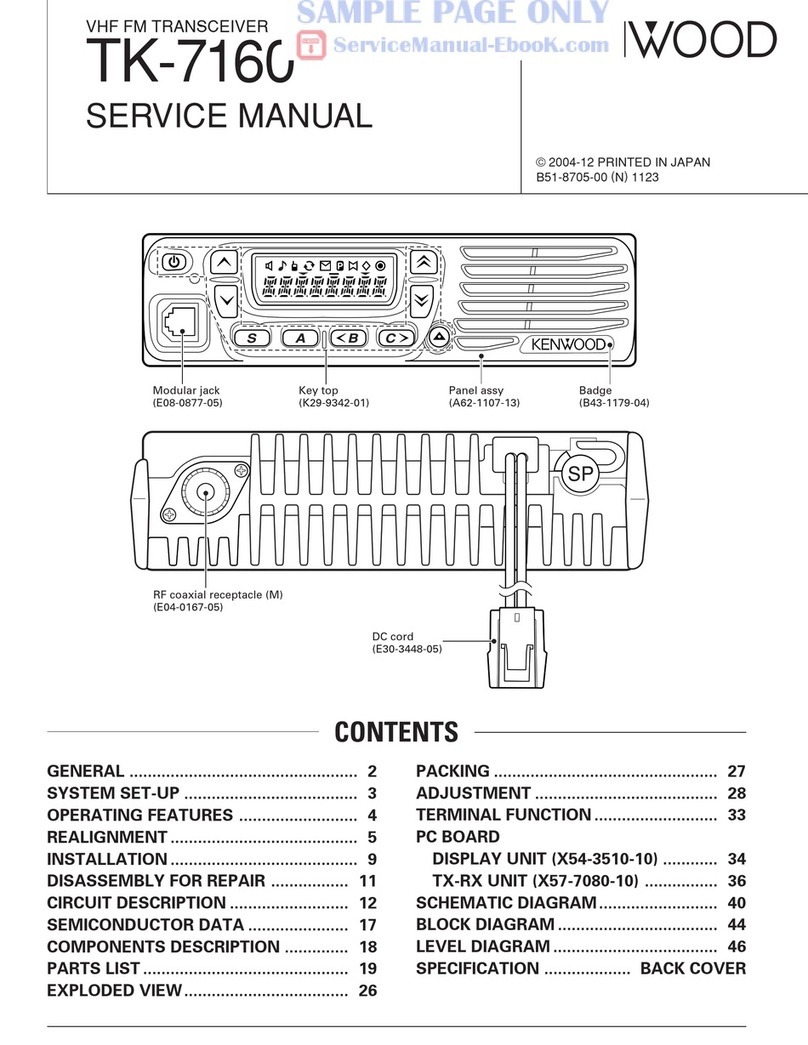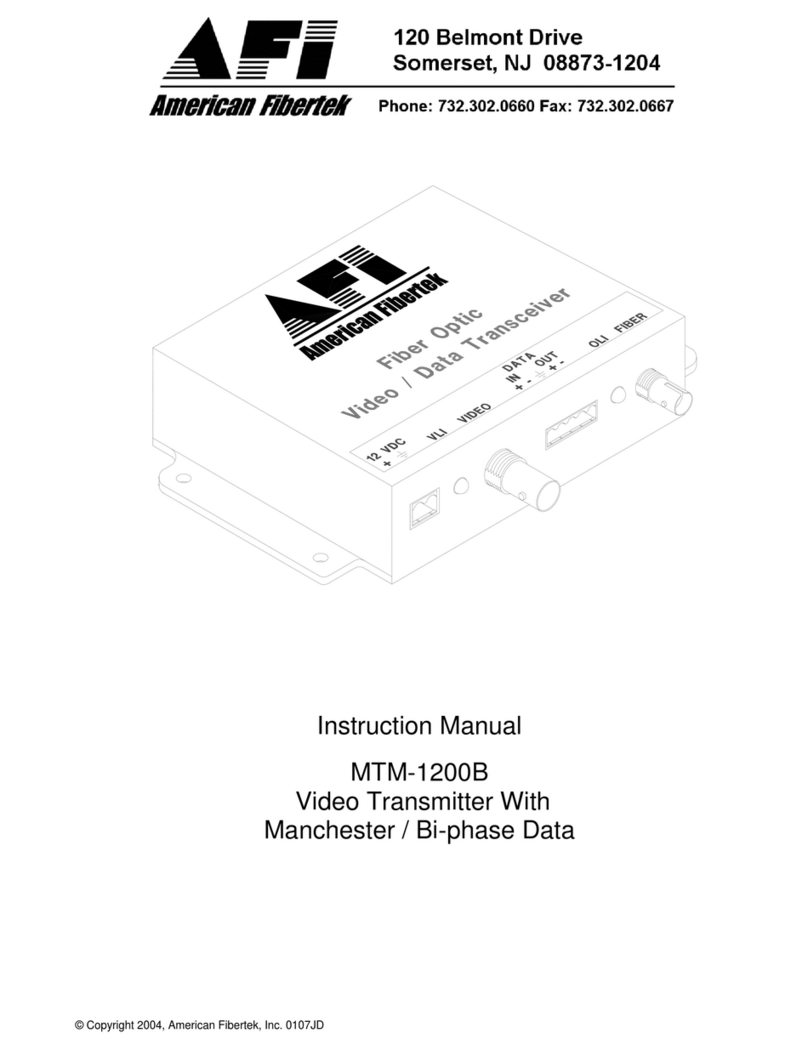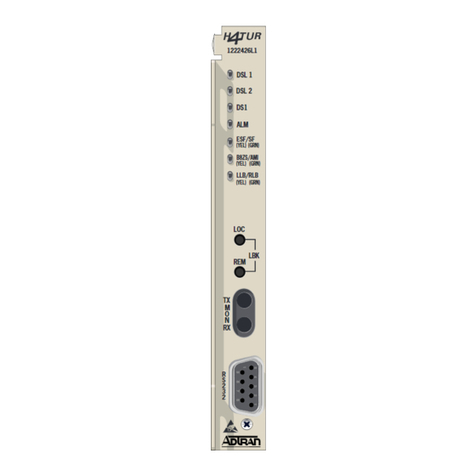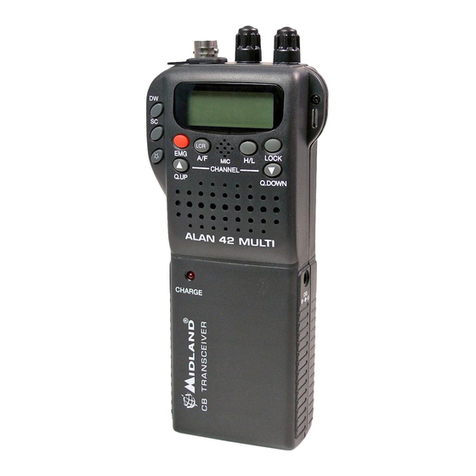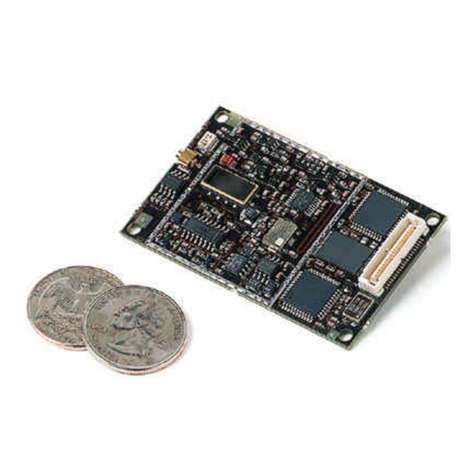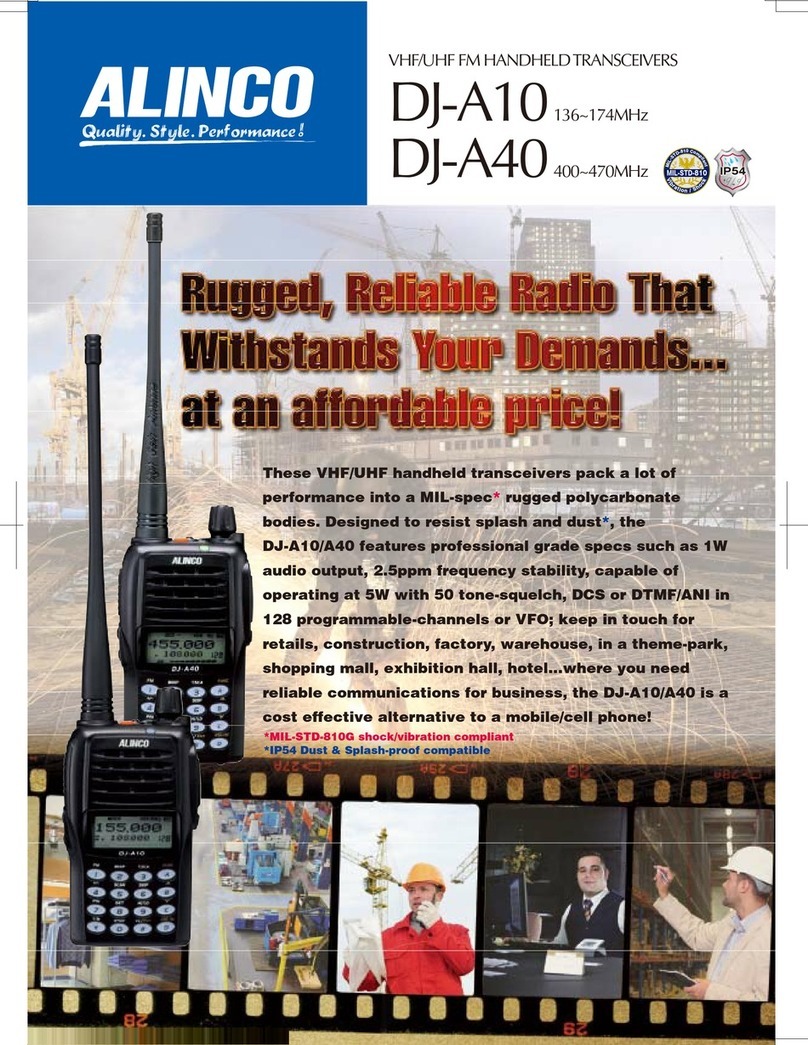Icom IC-F3022T User manual

INSTRUCTION MANUAL
iF3022T/S
VHF TRANSCEIVERS
The photo shows the 10-key
version VHF transceiver.
iF4022T/S
UHF TRANSCEIVERS

PRECAUTIONS
i
RDANGER! NEVER short the terminals of the battery
pack.
RDANGER! Use and charge only specified Icom bat-
tery packs with Icom radios or Icom chargers. Only Icom bat-
tery packs are tested and approved for use with Icom radios
or charged with Icom chargers. Using third-party or coun-
terfeit battery packs or chargers may cause smoke, fire, or
cause the battery to burst.
RWARNING! NEVER hold the transceiver so that
the antenna is very close to, or touching exposed parts of
the body, especially the face or eyes, while transmitting. The
transceiver will perform best if the microphone is 5 to 10 cm
away from the lips and the transceiver is vertical.
RWARNING! NEVER operate the transceiver with
a headset or other audio accessories at high volume levels.
Hearing experts advise against continuous high volume op-
eration. If you experience a ringing in your ears, reduce the
volume level or discontinue use.
RWARNING! NEVER operate the transceiver while
driving a vehicle. Safe driving requires your full attention—
anything less may result in an accident.
IMPORTANT
READ ALL INSTRUCTIONS carefully and com-
pletely before using the transceiver.
SAVE THIS INSTRUCTION MANUAL — This
instruction manual contains important operating instruc-
tions for the IC-F3022T/S VHF TRANSCEIVERS and the IC-
F4022T/S UHF TRANSCEIVERS.
This instruction manual includes some functions which
are usable only when they are pre-programmed by your
dealer. Ask your dealer for details.
EXPLICIT DEFINITIONS
WORD DEFINITION
RDANGER! Personal death, serious injury or an explo-
sion may occur.
RWARNING! Personal injury, fire hazard or electric
shock may occur.
CAUTION Equipment damage may occur.
NOTE
If disregarded, inconvenience only. No risk
of personal injury, fire or electric shock.

PRECAUTIONS
ii
CAUTION: MAKE SURE the flexible antenna and
battery pack are securely attached to the transceiver, and
that the antenna and battery pack are dry before attachment.
Exposing the inside of the transceiver to water will result in
serious damage to the transceiver.
DO NOT operate the transceiver near unshielded electrical
blasting caps or in an explosive atmosphere.
DO NOT push [PTT] when not actually intending to transmit.
DO NOT use or place the transceiver in direct sunlight or
in areas with temperatures below –25°C or above +55°C.
The basic operations, transmission and reception of the trans-
ceiver are guaranteed within the specified operating tempera-
ture range. However, the LCD display may not be operate
correctly, or show an indication in the case of long hours of
operation, or after being placed in extremely cold areas.
DO NOT modify the transceiver. The transceiver warranty
does not cover any problems caused by unauthorized modi-
fication.
DO NOT use harsh solvents such as benzine or alcohol
when cleaning, as they will damage the transceiver surfaces.
BE CAREFUL! The transceiver will become hot when
operating it continuously for long periods of time.
KEEP the transceiver away from the heavy rain, and Never
immerse it in the water. The transceiver meets IP54* require-
ments for dust-protection and splash resistance.
However, once the transceiver has been dropped, dust-pro-
tection and splash resistance cannot be guaranteed due to
the fact that the transceiver may be cracked, or the water-
proof seal damaged, etc.
* Only when the supplied battery pack, flexible antenna and jack
cover are attached.
Even when the transceiver power is OFF, a slight current still
flows in the circuits. Remove the battery pack or batteries from
the transceiver when not using it for a long time. Otherwise,
the installed battery pack or batteries will become exhausted,
and will need to be recharged or replaced.
MAKE SURE to turn the transceiver power OFF before
connecting the supplied/optional equipment.
Icom, Icom Inc. and the Icom logo are registered trademarks of Icom
Incorporated (Japan) in Japan, the United States, the United Kingdom,
Germany, France, Spain, Russia and/or other countries.

iii
TABLE OF CONTENTS
IMPORTANT.......................................................................... i
EXPLICIT DEFINITIONS....................................................... i
PRECAUTIONS..................................................................... i
TABLE OF CONTENTS....................................................... iii
1 ACCESSORIES ...........................................................1–2
■ Supplied accessories ...................................................1
■ Accessory attachments ................................................1
2 PANEL DESCRIPTION................................................3–8
■ Front panel ...................................................................3
■ Function display ...........................................................4
■ Programmable function keys........................................5
3 BASIC OPERATION..................................................9–15
■ Turning power ON ........................................................9
■ Channel selection.......................................................10
■ Call procedure............................................................10
■ Receiving and transmitting.........................................11
■ User set mode............................................................13
■ Stun function ..............................................................13
■ Emergency Call..........................................................14
■ Man Down Emergency Call........................................14
■ Scrambler function .....................................................14
■ Priority A channel selection........................................14
■ MDC 1200 system operation......................................15
4 BATTERY CHARGING ............................................16–20
■ Caution.......................................................................16
■ Optional battery chargers...........................................18
5 BATTERY CASE............................................................21
■ Optional battery case (BP-240)..................................21
6 OPTIONAL SWIVEL BELT CLIP ............................22–23
■ MB-93 contents ..........................................................22
■ Attaching ....................................................................22
■ Detaching ...................................................................23
7 OPTIONS.................................................................24–25
8 COUNTRY CODE LIST .................................................26

1
1
ACCESSORIES
1
■Supplied accessories
■Accessory attachments
DFlexible antenna
Connect the supplied flexible antenna
to the antenna connector.
CAUTION:
• NEVER carry the transceiver by
holding the antenna.
• DO NOT connect the antenna
other than listed on p. 25.
• Transmitting without an antenna
may damage the transceiver.
DBattery pack
To attach the battery pack:
Slide the battery pack in the direction of the arrow (q), then
lock it with the battery release button.
• Slide the battery pack until the battery release button makes a
‘click’ sound.
To release the battery pack:
Slide the battery release button in the direction of the arrow
(w) as shown below. The battery pack is then released.
NEVER release or attach the battery pack when the trans-
ceiver is wet or soiled. This may result water or dust get-
ting into the transceiver or battery pack, and may result in
them being damaged.
q
w
Battery release button
NOTE: Keep the battery pack terminals clean. It’s a good
idea to clean the battery pack terminals once a week.
Flexible antenna Battery pack Belt clip
Unit cover (double-sided tape)*
Jack cover (with screws)
*Use the unit cover
as a spare. Ask your
dealer for details.

2
1ACCESSORIES
DBelt clip
To attach the belt clip:
qRelease the battery pack if it is attached. (p. 1)
wSlide the belt clip in the direction of the arrow until the belt
clip locks in place, and makes a ‘click’ sound.
To detach the belt clip:
qRelease the battery pack if it is attached. (p. 1)
wLift the tab up (q), and slide the belt clip in the direction of
the arrow (w).
q
w
DJack cover
Attach the jack cover when the optional speaker-microphone
or headset is not used.
To attach the jack cover:
qAttach the jack cover to
the [MIC/SP] jack.
wTighten the screws.
To detach the jack cover:
qUnscrew the screws using
a phillips screwdriver.
wDetach the jack cover for
the speaker-microphone
or headset connection.
qw
[MIC/SP] jack
Jack cover
q
q
w
CAUTION:
Use the supplied screws only.

3
2
PANEL DESCRIPTION
1
2
3
4
5
6
7
8
9
10
11
12
13
14
15
16
■Front panel
qANTENNA CONNECTOR
Connects the supplied antenna.
wDEALER-PROGRAMMABLE KEY [Emer]
Desired function can be programmed by your dealer. (p. 5)
eDEALER-PROGRAMMABLE KEY [Side1]
Desired function can be programmed by your dealer. (p. 5)
r PTT SWITCH [PTT]
Push and hold to transmit; release to receive.
tDEALER-PROGRAMMABLE KEYS [Side2]/[Side3]
Desired functions can be programmed independently by
your dealer.
(p. 5)
y10-KEYPAD (Depending on version)
The keypad allows you to enter digits to:
• Select memory channels
• Select tone channels
• Select DTMF codes (during transmit)
• Set TX codes
• Start up with the password
uDEALER-PROGRAMMABLE KEYS [P0] to [P3]
Desired functions can be programmed independently by
your dealer.
(p. 5)
iFUNCTION DISPLAY (p. 4)
Displays a variety of information such as an operating
channel number/name, 5-tone code, DTMF numbers, se-
lected function, etc.
o EXTERNAL MICROPHONE/SPEAKER JACK
Connect an optional speaker-microphone or headset.
NOTE: Connect or disconnect the optional equipment
after the transceiver is turned OFF.
!0 VOLUME CONTROL [VOL]
Rotate to turn the power ON/OFF and adjusts the audio level.
Jack cover
NOTE: Attach the jack
cover when the optional
equipment is not used.
See page 2 for details.
q
w
r
eo
i
u
y
Microphone
Speaker
t
!0

4
2PANEL DESCRIPTION
■Function display
qTRANSMIT INDICATOR
Appears while transmitting.
wBUSY INDICATOR
Appears while the channel is busy.
eSIGNAL STRENGTH INDICATOR
Indicates relative signal strength level.
rLOW POWER INDICATOR
Appears when low output power is selected.
• When the battery power decreases to a specified level, low
power is selected automatically.
tAUDIBLE INDICATOR
➥Appears when the channel is in the ‘audible’ (unmute)
condition.
➥Appears when the specified 5-tone code is received.
ySCRAMBLER INDICATOR
Appears when the voice scrambler function is activated.
uBELL INDICATOR
Appears/blinks when the specific 5-tone code is received,
according to the pre-programming.
iKEY LOCK INDICATOR
Appears during the key lock function is ON.
oBATTERY INDICATOR
Appears or blinks when the battery power decreases to a
specified level.
!0 ALPHANUMERIC DISPLAY
Displays an operating channel number, channel name,
Set mode contents, DTMF code, etc.
yq iutrew
o
!0

5
2
PANEL DESCRIPTION
2
■Programmable function keys
The following functions can be assigned to [Emer],[Side1],
[Side2], [Side3], [P0], [P1], [P2] and [P3] programmable
function keys.
Consult your Icom dealer or system operator for details con-
cerning your transceiver’s programmed keys and their func-
tions.
CH UP AND DOWN KEYS
➥Push to select an operating channel.
➥Push to select a transmit code channel after pushing [TX
Code CH Select]. (p. 12)
➥Push to set a transmit code digit after pushing [TX Code
CH Select] or [TX Code CH Enter]. (pp. 12, 13)
➥Push to select a DTMF channel after pushing [DTMF Au-
todial].
➥Push to select a scan group after pushing and holding
[Scan A Start/Stop]/[Scan B Start/Stop] for 1 sec.
ZONE KEY
Push this key, then push [CH Up] or [CH Down] to select the
desired zone.
What is “zone”?— The desired channels are assigned
into a zone according to the intended use for grouping. For
example, ‘Staff A’ and ‘Staff B’ are assigned into a “Busi-
ness” zone, and ‘John’ and ‘Cindy’ are assigned into a “Pri-
vate” zone.
SCAN A KEY
➥This key’s operation depends on the Power ON Scan set-
ting.
When the power ON scan function is turned OFF;
Push to start and cancel scanning operation. In case of
transmission during scan, scanning will be cancelled.
When the power ON scan function is turned ON;
Push to pause scanning, then resumes scanning after
passing a specified time period. In case of transmission
during scan, scanning will be cancelled.
➥
Push and hold this key for 1 sec. to indicate the scan group,
then push [CH Up] or [CH Down] to select the desired group.
SCAN B KEY
➥Push to start and cancel scanning operation. In case of
transmission during scan, scanning will be paused. Then
resumes scanning after passing a specified time period.
➥
Push and hold this key for 1 sec. to indicate the scan group,
then push [CH Up] or [CH Down] to select the desired group.

6
2PANEL DESCRIPTION
SCAN ADD/DEL (TAG) KEY
➥Push to add a channel to, or delete it from the current scan
list.
• When a channel is added to the current scan list, the display
shows “SCAN ON.” When a channel is deleted from the current
scan list, the display shows “SCAN OFF.” After showing “SCAN
ON” or “SCAN OFF,” the display shows the current scan list text.
➥You can add a channel to, or delete it from the scan list
after selecting the list.
1. Hold down for 1 sec. to display the current scan list, and then
push [CH Up] or [CH Down] to select a desired list.
2. Push this key to add a channel to, or delete it from the selected
list.
• When a channel is added to the selected scan list, the display
shows “SCAN ON.” When a channel is deleted from the
selected scan list, the display shows “SCAN OFF.”
3. Hold down this key for 1 sec. to exit the scan list selection
mode.
➥Push this key while a scan is paused on a channel, except
for primary or secondary channel, and then the channel is
deleted from the scan list.
• Depending on the setting, the deleted channel is added to the
scan list again after the scan is cancelled. (Nuisance Delete
function)
MR-CH 1/2/3/4 KEYS
Push to select memory channels 1 to 4 in the operating zone
directly.
WIDE/NARROW KEY
Push to toggle the IF bandwidth between wide, mid* and nar-
row.
• The wide passband width can be selected from 20.0 or 25.0 kHz
using the CS-F3020/F5010/F5020 c l o n i n g s o f t w a r e . (PMR op-
eration only) Ask your dealer for details.
*Depending on the presetting, the mid width may not be selectable.
Ask your dealer for details.
PRIO A/B KEYS
➥Push to select Priority A or Priority B channel.
➥Push and hold [Prio A (Rewrite)] or [Prio B (Rewrite)] for 1
sec. to reassign the operating channel to Priority A or Pri-
ority B channel.
MONI KEY
Mute and release the CTCSS (DTCS) or 5-tone squelch mute.
Open any squelch/deactivate any mute while pushing this key.
LOCK KEY
➥Push and hold for 1 sec. to electronically lock all program-
mable keys except the following:
[Call] (incl. Call A and Call B), [Moni], [Emergency],
[Surveillance], [Siren], [Lone Worker] and [OPT 1/2/3].
➥Push and hold for 1 sec. again to turn the lock function
OFF.
HIGH/LOW KEY
Push to select the transmit output power temporarily or per-
manently, depending on the pre-setting.
• Ask your dealer for the output power level for each selection.

7
2
PANEL DESCRIPTION
2
C.TONE CH ENT KEY
Push to select the continuous tone channel using
[CH Up]/[CH Down] to change the tone frequency/code set-
ting. The selected channel remains set as the continuous
tone channel until another channel is designated as such.
TALK AROUND KEY
Push to turn the talk around function ON and OFF.
• The talk around function equalizes the transmit frequency to the
receive frequency for transceiver-to-transceiver communication.
DTMF AUTODIAL KEY
➥
Push to enter the DTMF channel selection mode. Then select
the desired DTMF channel using [CH Up]/[CH Down].
➥After selecting the desired DTMF channel, push this key to
transmit the DTMF code.
RE-DIAL KEY
Push to transmit the last-transmitted DTMF code.
CALL KEYS
Push to transmit a 5-tone.
• Call transmission is necessary before you call another station
depending on your signaling system.
• [Call A] and/or [Call B] may be available when your system employs
selective ‘Individual/Group’ calls. Ask your dealer which call is
assigned to each key.
EMERGENCY KEY
Push and hold to transmit the emergency call.
• The transceiver can transmit the emergency call silently or audibly
depending on the pre-setting. Ask your dealer for details.
• When the emergency call transmits with beeps, the emergency text
is displayed on the LCD if programmed.
• If you want to cancel the emergency call, push (or push and hold)
the key again before transmitting the call.
• The emergency call is transmitted one time only or repeatedly until
receiving a control code, depending on the pre-setting.
SURVEILLANCE KEY
Push to turn the surveillance function ON or OFF.
When this function is turned ON, the beep is not emitted and
the LCD backlight does not light when a signal is received or
a key is pushed, etc.
SIREN KEY
Push to emit a siren.
TX CODE ENTER KEY
Push to enter the ID code edit mode directly, for 5-tone. Then set
the desired digit using [CH Up]/[CH Down] or 10-keypad*. (p. 13)
*10-key versions only

8
2PANEL DESCRIPTION
TX CODE CHANNEL SELECT KEY
➥Push to enter the ID code channel selection mode directly.
Then set the desired channel using [CH Up]/[CH Down].
(p. 12)
➥During ID code channel selection mode, push and hold for
1 sec. to enter the ID code edit mode for 5-tone code.Then
set the desired digit using [CH Up]/[CH Down] or 10-key-
pad*. (p. 12)
*10-key versions only
TX CODE CHANNEL UP/DOWN KEYS
Push to select a TX code channel directly.
ID-MR SELECT KEYS
➥Recalls detected ID codes.
•
Push this key, then select the ID code using [CH Up]/[CH Down].
• Up to 5 ID’s are memorized.
➥Push and hold for 1 sec. to erase the selected ID’s.
LONE WORKER KEY
Push to turn the Lone Worker function ON or OFF.
• If the Lone Worker function is activated, the Emergency function is
automatically turned ON after the specified time period has passed
with no operation is performed.
SCRAMBLER FUNCTION
Push to toggle the voice scrambler function ON and OFF.
USER SET MODE KEY
➥Push and hold for 1 sec. to enter user set mode.
• During in the user set mode, push this key to select an item that
is enabled by your dealer, and change the value or condition by
pushing [CH Up] or [CH Down].
➥
Push and hold this key for 1 sec. again to exit user set mode.
User set mode is also available via the ‘Power ON function.’
Refer to page 13 also.
OPT OUT KEYS
Push to control the output signal level of the optional ports in
the optional unit connector.
OPT MOMENTARY KEYS
Controls the output signal level of the optional ports in the
optional unit connector while pushing and holding this key.

9
3
BASIC OPERATION
1
2
3
4
5
6
7
8
9
10
11
12
13
14
15
16
■Turning power ON
Prior to using the transceiver for the first time, the battery
pack must be fully charged for optimum life and operation.
(p. 18)
qRotate [VOL] to turn the power ON.
wIf the transceiver is programmed for a start up password,
input the digit codes as directed by your dealer.
• 10-keypad can be used for password input depending on ver-
sion:
• The keys in the table below can be used for password input:
• The transceiver detects numbers in the same block as identical.
Therefore “01234” and “56789” are the same.
e When the “PASSWORD” indication does not clear after
inputting 4 digits, the input code number may be incorrect.
Turn the power off and start over in this case.
DBattery type selection
The battery type must be selected according to the attaching
battery type when turning the transceiver ON.
Ask your dealer for details.
qTurn the power OFF.
w While pushing and holding [Emer] and [PTT], turn the
power ON with rotating [VOL] to toggle the attaching bat-
tery type.
• After the display appears, release [Emer] and [PTT].
• “DRY BATT” is displayed for about 3 sec. then “L” appears when
the battery case operation is selected. In this case, the transmit
output power is low.
• “LI-ION” is displayed for about 3 sec. when the Lithium-ion bat-
tery operation is selected.
[VOL]
[PTT]
[Emer]
Dry battery mode
Appears
KEY
NUMBER 0
5
4
9
3
8
2
7
1
6
[Side3]
[P0]/[P1]/
[P2]/[P3]
Side3
[VOL]

10
3BASIC OPERATION
■Channel selection
Several types of channel selections are available. Methods
may differ according to your system set up.
NON-ZONE TYPE:
Push [CH Up] or [CH Down] to select the desired operating
channel, in sequence; or, push one of [MR-CH 1] to [MR-CH 4]
keys to select a channel directly.
ZONE TYPE:
Push [Zone], then push [CH Up] or [CH Down] to select the
desired zone.
AUTOMATIC SCAN TYPE:
Channel setting is not necessary for this type. When turning
power ON, the transceiver automatically starts scanning.
Scanning stops when receiving a call.
■Call procedure
When your system employs tone signaling (excluding CTCSS
and DTCS), the call procedure may be necessary prior to voice
transmission. The tone signaling employed may be a selective
calling system which allows you to call specific station(s) only
and prevent unwanted stations from contacting you.
qSelect the desired TX code channel or 5-tone code ac-
cording to your System Operator’s instructions.
• This may not be necessary depending on programming.
• Refer to page 12 for selection.
wPush the call key (assigned to one of the dealer program-
mable keys: [Emer], [Side1], [Side2], [Side3], [P0], [P1],
[P2] and [P3]) or [PTT].
eAfter transmitting a 5-tone code, the remainder of your
communication can be carried out in the normal fashion.
Selective calling Non-selective calling

11
3
BASIC OPERATION
3
■Receiving and transmitting
NOTE: Transmitting without an antenna may damage the
transceiver. See page 1 for accessory attachments.
Receiving:
qRotate [VOL] to turn the power ON.
wPush [CH Up] or [CH Down] to select the conventional
system channel, in sequence.
e When receiving a call, adjust the audio output level to a
comfortable listening level.
NOTE: When a matched RX code signal is received, audio
from the microphone is automatically transmitted for a
specified time period.*
* Depending on the presetting. Ask your dealer for details.
Transmitting:
Wait for the channel to become clear to avoid interference.
qPush [Call] when initiating a call from your side.
• Coded audio may be heard from the transceiver, then “ ” ap-
pears.
• This operation may not be necessary depending on your signal-
ing system. Ask your dealer for details.
w While pushing and holding [PTT], speak into the micro-
phone at a normal voice level.
eRelease [PTT] to return to receive.
IMPORTANT: To maximize the readability of your signal;
1. Pause briefly after pushing [PTT].
2. Hold the microphone 5 to 10 cm from your mouth, then
speak into the microphone at a normal voice level.
DTransmitting notes
• Transmit inhibit function
The transceiver has several inhibit functions which restrict
transmission under the following conditions:
- The channel is in mute condition (‘Inaudible’ condition;
“” does not appear.)
- The channel is busy.
- Un-matched (or matched) CTCSS is received.
(Depending on the pre-setting.)
- The selected channel is a ‘receive only’ channel.
• Time-out timer
After continuous transmission for the pre-programmed time
period, the time-out timer is activated, causing the transceiver
to stop transmitting.
• Penalty timer
Once the time-out timer is activated, transmission is further
inhibited for a period determined by the penalty timer.
• PTTID call
The transceiver sends the ID code (5-tone, DTMF or digital
ANI) automatically when [PTT] is pushed (beginning of trans-
mission) and released (end of transmission) depends on the
setting.

12
3BASIC OPERATION
DTX code channel selection
If the transceiver has [TX Code CH Select] assigned to it, the
indication can be switched between the operating channel
number (or name) and TX code channel number (or name).
When the TX code channel number (or name) is displayed,
[CH Up] or [CH Down] selects the TX code channel.
USING [TX CODE CH SELECT] KEY:
qPush [TX Code CH Select]— a TX code channel number
(or name) appears.
wPush [CH Up] or [CH Down] to select the desired TX code
channel.
eAfter selecting, push [TX Code CH Select] to set.
• Return to the stand-by mode.
rPush [Call] to transmit the selected TX code.
USING [TX CODE CH UP]/[TX CODE CH DOWN] KEY:
If the transceiver has [TX Code CH Up] or [TX Code CH
Down] assignment, the programmed TX code channel can
be selected directly when pushed.
DTX code number edit
If the transceiver has [TX Code CH Select] or [TX Code
Enter] assigned to it, TX code contents can be edited within
the allowable digits.
USING [TX CODE CH SELECT] KEY:
qPush [TX Code CH Select] to enter the TX code channel
selection mode.
• Select the desired channel with [CH Up] or [CH Down] if neces-
sary.
wPush and hold [TX Code CH Select] for 1 sec. to enter
the TX code edit mode.
ePush [TX Code CH Select] several times to select the de-
sired digit to be edited.
• The digit to be edited blinks.
rPush [CH Up], [CH Down] or 10-keypad* to set the de-
sired digit.
tPush [TX Code CH Select] to set the digit. The digit to the
right will blink automatically.
•
When the 10-keypad* is used for setting, the digit to be edited moves
to the right automatically without pushing [TX Code CH Select].
yRepeat rand tto input all allowable digits.
uAfter setting the last digit, push [TX Code CH Select] to
set the code and return to the stand-by mode.

13
3
BASIC OPERATION
3
USING [TX CODE ENTER] KEY:
qSelect the desired TX code channel. (p. 12)
wPush [TX Code Enter] to enter the TX code edit mode.
• The digit to be edited blinks.
ePush [TX Code Enter] several times to select the desired
digit to be edited.
rPush [CH Up], [CH Down] or 10-keypad* to set the de-
sired digit.
tPush [TX Code Enter] to set the digit. The digit to the right
will blink automatically.
•
When the 10-keypad* is used for setting, the digit to be edited
moves to the right automatically without pushing [TX Code Enter].
yRepeat rand tto input all allowable digits.
uAfter setting the last digit, push [TX Code Enter] to set the
code and return to the stand-by mode.
*10-key versions only
DDTMF transmission
If the transceiver has [DTMF Autodial] assigned to it, the
automatic DTMF transmission function is available. Up to 8
DTMF channels are available.
TO SELECT A TX CODE:
qPush [DTMF Autodial]— a DTMF channel appears.
wPush [CH Up] or [CH Down] to select the desired DTMF
channel.
ePush [DTMF Autodial] to transmit the DTMF code in the
selected DTMF channel.
■User set mode
User set mode is accessed at power ON and allows you to set
seldom-changed settings. In this case you can “customize” the
transceiver operation to suit your preferences and operating style.
Entering the user set mode:
q While pushing and holding [Side2] and [Side3], rotate
[VOL] to turn the power ON. Then, push and hold [P0] for
1 sec. to enter user set mode.
wPush [P0] several times to select the appropriate item.
Then push [CH Up] or [CH Down] to set the desired level/
condition.
• Available set mode functions are Backlight, Beep, Beep
Level, SQL Level, Mic Gain, Battery Voltage Signal Moni
and Lone Worker.
eRotate [VOL] to turn the power OFF to exit user set mode.
NOTE: User set mode is also available via a programma-
ble function key. Refer to “USER SET MODE KEY.” (p. 8)
■Stun function
When the specied ID, set as a killer ID, is received, the stun
function is activated.
When the killer ID is received, the transceiver switches to
the password required condition. Entering of the password
via the keypad is necessary to operate the transceiver again
in this case. (p. 9)

14
3BASIC OPERATION
■Emergency Call
The emergency call can be performed with [Emergency] (p. 7).
The transceiver will send a 5-tone, DTMF or MDC 1200
emergency signal* one time only or repeatedly on the emer-
gency channel. However, when no emergency channel is
specified, the signal is transmitted on the previously selected
channel.
If you want to cancel the emergency call, push and hold the
key again before transmitting the call.
* Depending on the operating model type.
■Man Down Emergency Call
This function requires the optional UT-124R man d o w n unit
and can be performed in conventional mode.
The man down emergency call function transmits an emer-
gency call automatically when the transceiver has been left
in a horizontal position.
After the emergency call, the transceiver performs transmis-
sion and reception alternately with receiving a signal and
emitting audio.
When the emergency reset signal is received, the function is
cancelled.
IMPORTANT: Set an emergency channel individually, to
provide certain emergency call operation is recommended.
■Scrambler function
The voice scrambler function provides private communica-
tion between stations. The optional Rolling or Non-rolling
type can be available.
qPush [Scrambler] to turn the scrambler function ON.
• “ ” appears.
wPush [Scrambler] again to turn the scrambler function
OFF.
• “ ” disappears.
■Priority A channel selection
When one of the following operations is performed, the
transceiver selects the Priority A channel automatically.
Priority A is selected when;
• Clear down signal is received/transmitted
- Set the ‘Move to PrioA CH’ item as ‘Clear down.’
• Turning the power ON
The Priority A channel is selected each time the trans-
ceiver power is turned ON.
• Status call
The Priority A channel is selected when transmitting a
status call.

15
3
BASIC OPERATION
3
■MDC 1200 system operation
DReceiving an Emergency Call
q When an emergency call is received;
• Beeps sound.
• The calling station alias and “EMG EMG” are displayed alter-
nately.
wTurn power OFF, change the channel, push [PTT] for re-
plying the call, etc. to stop the beep and display indication.
DReceiving a Stun and Revive
The dispatcher can send MDC 1200 system signals that
will stun or revive your transceiver. If a Stun command is
received that matches your station ID, the transceiver will
display “SORRY” (default) and you can not receive or trans-
mit. When a Revive command is received that matches your
station ID, normal operation is restored.

16
4BATTERY CHARGING
■Caution
Misuse of Lithium-ion batteries may result in the following
hazards: smoke, fire, or the battery may rupture. Misuse
can also cause damage to the battery or degradation of
battery performance.
RDANGER! Use and charge only specified Icom battery
packs with Icom radios or Icom chargers. Only Icom battery
packs are tested and approved for use and charge with Icom
radios or Icom chargers. Using third-party or counterfeit bat-
tery packs or chargers may cause smoke, fire, or cause the
battery to burst.
DBattery caution
RDANGER! DO NOT hammer or otherwise impact the bat-
tery. Do not use the battery if it has been severely impacted
or dropped, or if the battery has been subjected to heavy
pressure. Battery damage may not be visible on the outside
of the case. Even if the surface of the battery does not show
cracks or any other damage, the cells inside the battery may
rupture or catch fire.
RDANGER! NEVER use or leave battery packs in areas
with temperatures above +60˚C. High temperature buildup in
the battery, such as could occur near fires or stoves, inside
a sun heated car, or in direct sunlight may cause the battery
to rupture or catch fire. Excessive temperatures may also
degrade battery performance or shorten battery life.
RDANGER! DO NOT expose the battery to rain, snow,
seawater, or any other liquids. Never charge or use a wet
battery. If the battery gets wet, be sure to wipe it dry before
using. The battery is not waterproof.
RDANGER! NEVER incinerate used battery packs since
internal battery gas may cause them to rupture, or may
cause an explosion.
RDANGER! NEVER solder the battery terminals or NEVER
modify the battery pack. This may cause heat generation,
and the battery may rupture, emit smoke or catch fire.
RDANGER! Use the battery only with the transceiver for
which it is specified. Never use a battery with any other
equipment, or for any purpose that is not specified in this in-
struction manual.
RDANGER! If fluid from inside the battery gets in your
eyes, blindness can result. Rinse your eyes with clean water,
without rubbing them, and see a doctor immediately.
WARNING! Immediately stop using the battery if it emits an
abnormal odor, heats up, or is discolored or deformed. If any of
these conditions occur, contact your Icom dealer or distributor.
This manual suits for next models
3
Table of contents
Other Icom Transceiver manuals
